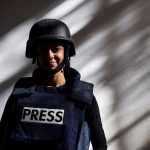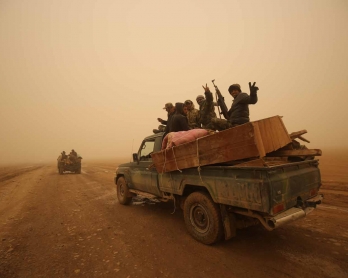A tale of two cities
Mosul -- "There are families living in this alleyway.” The Arabic words were hand-painted in red, black, and blue on a tattered canvas, pinned up where a small side street led off a main thoroughfare in Iraq's Mosul. The alleyway looked anything but livable — bullet holes and craters from mortar rounds still scarred the walls around it nearly two years after the fighting had stopped, and sewage water gurgled down the cracked pavement. The banner, my AFP colleagues said, was hung to alert passing aid groups to needy residents eking out a living, unseen, in the battered labyrinth of west Mosul.
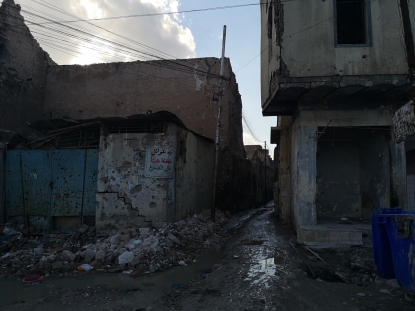 "There are families living in this alleyway," reads the sign hung in west Mosul. February, 2019. (Photo courtesy of Maya Gebeily)
"There are families living in this alleyway," reads the sign hung in west Mosul. February, 2019. (Photo courtesy of Maya Gebeily)It was my first time back in Mosul since a brief assignment for AFP in October 2016, when the Iraqi military was waging a massive offensive to oust the Islamic State group. That fight took nine brutal, bloody months, its objective was carefully defined, materially supported, and ultimately achieved -- with meticulous coverage by global media.
What I slowly absorbed after a few days in post-IS Mosul -- and its Syrian twin city Raqa a few weeks later -- is that what comes after is infinitely more complex to chart out and to report faithfully. There is no step-by-step strategy to rebuild a city's spirit. There's no unified command-and-control center. It's usually not even clear what victory is supposed to look like or when it can be declared. But just as we have covered every aspect of the military struggle, we should carefully and passionately provide testimony from the cities and societies painstakingly lifting themselves out of war.
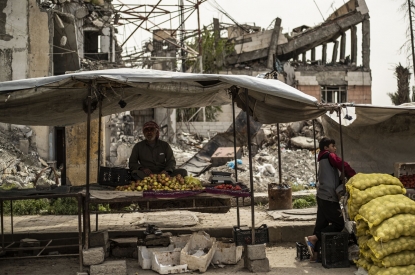 A fruit and vegetable seller waits for customers in a makeshift shop set in front of destroyed buildings in the northern Syrian city of Raqa, the former Syrian capital of the Islamic State (IS) group, on April 14, 2019. (AFP / Delil Souleiman)
A fruit and vegetable seller waits for customers in a makeshift shop set in front of destroyed buildings in the northern Syrian city of Raqa, the former Syrian capital of the Islamic State (IS) group, on April 14, 2019. (AFP / Delil Souleiman)On a cold February morning, we entered Mosul from the east, left more intact than the western half across the river Tigris. Some areas were immediately familiar: a highway intersection that had been too dangerous to cross because IS militants were within firing range in a nearby cemetery. A field where foreign medics had treated wounded Iraqi civilians and soldiers. A gap between two neighborhoods where, over the course of our 2016 assignment, I had watched an anonymous corpse sink day by day into muddy water until it was completely submerged. Now a paved road ran through the area, complete with stoplights dictating the flows of rush hour traffic. How much else — how many more — lay underneath the freshly-laid asphalt?
After reporting from a clinic run by Doctors Without Borders, we stopped at a busy family restaurant for a late lunch of grilled sheep testicles, an ambitious order I would see again in a few hours. From there, we walked through a crowded market to the Nabi Yunus mosque, which IS had ransacked and destroyed when it overran the city in 2014. The steps leading up to its courtyard were teeming with young men and couples enjoying the waning hours of the winter afternoon. Much of the east was like this: a monument that had been transformed into the site of a world-infamous atrocity, papered over by scenes of normality.
 The Great Mosque of al-Nuri and the remains of Al-Hadba leaning minaret in Mosul's Old City, December 16, 2018.
(AFP / Zaid Al-obeidi)
The Great Mosque of al-Nuri and the remains of Al-Hadba leaning minaret in Mosul's Old City, December 16, 2018.
(AFP / Zaid Al-obeidi)There was no such veil for the west.
The west was home to the city’s oldest heritage, its celebrated museum, its once-beloved leaning minaret and adjacent Nuri Mosque — where IS chief Abu Bakr al-Baghdadi in 2014 anointed himself “caliph” of swathes of Syria and Iraq. The west is also where IS made its last stand for Mosul, pummeled heavily by Iraqi security forces. I did not cover that stage of the offensive, but my colleagues at AFP and dozens of other outlets had documented the relentless ferocity of those final days. I braced myself.
Crossing the river Tigris on a metal bridge, we approached the western bank head-on. It took me a moment to realize that the small mountains on the other side were not in fact hills of dirt or trash dumps, but were the remnants of homes, shops, and mosques, reduced to virtually indistinguishable berms of debris. It was a fitting introduction to the rest of the west: broad streets lined with pulverized buildings, broken up by empty lots whose structures had been totally razed. Nearly two years after the city was recaptured, the bulldozers and cranes there were still tearing things down, wiping them from memory, instead of rebuilding them.
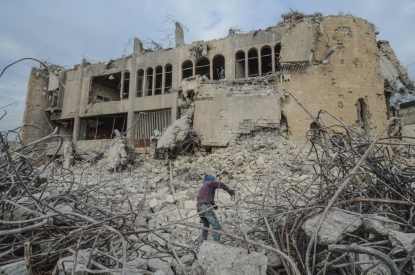 An Iraqi scavenges for metal from the rubble of destroyed building in Mosul, January, 2019. (AFP / Zaid Al-obeidi)
An Iraqi scavenges for metal from the rubble of destroyed building in Mosul, January, 2019. (AFP / Zaid Al-obeidi)One such structure was the National Insurance Company, from whose roof IS infamously used to throw men accused of being gay. The building was an icon of modern architecture in Mosul, and a debate had been raging over whether its carcass should stay erect. I asked my colleagues from Mosul, with whom I was traveling, if they thought it was important to transform the building into a monument to IS’s victims.
“Of course. We need to remember everything that happened here,” said one enthusiastically, who had lived in Mosul for a few months under IS, then escaped to Baghdad.
After a long pause: “No,” my second colleague murmured. He had spent all three years of IS rule in Mosul. “Every sign of them, everything they did, should be erased.”
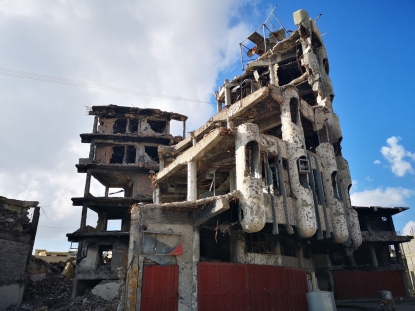 Mosul, February 2019. (Photo courtesy of Maya Gebeily)
Mosul, February 2019. (Photo courtesy of Maya Gebeily)We rumbled on in silence and arrived at what was left of the Nuri Mosque, birthplace of IS's "caliphate." The site had not yet been cleared for visits, and a member of the security forces eyed us warily as we descended from the car. The ornate gate leading to the mosque's courtyard was riddled with bullet holes but still standing, and featured another drooping canvas banner half-heartedly promising the site's rehabilitation in English. I stepped around the gate and into the courtyard to take in the mosque and its pockmarked blue-green dome. It had mostly been hollowed out by fighting, and I could see all the way through inside of it. "Fuck ISIS," someone had spray-painted in a corner, again in English. Across the courtyard, the famous leaning minaret of al-Hadhba had been reduced to a stub.
I wondered where exactly Baghdadi had stood when he made his first appearance in 2014, and the unimaginable ripple effects of his words. I thought of the tightly-knit societies they had torn apart, of childhoods condemned to displacement camps, of the effect of watching so many beheadings and lashings on our collective threshold for violence. I don't consider myself superstitious, but the energy pulsating around Al-Nuri felt nothing short of evil. Like it had given birth to something poisonous and was still rotting from the inside. Like the site, despite its centuries of history, could not shake the legacy of depravity IS had forced upon it.
 A general view shows Mosul's Old City, on January 8, 2018, six months after Iraqi forces seized the country's second city from Islamic State group jihadists. (AFP / Ahmad Al-rubaye)
A general view shows Mosul's Old City, on January 8, 2018, six months after Iraqi forces seized the country's second city from Islamic State group jihadists. (AFP / Ahmad Al-rubaye)Weaving our way back towards the river bank, we drove by back-to-back storefronts that were burned, broken and abandoned, like rows of cavity-filled teeth. They were interrupted by a single shop displaying home-ware for sale — neon-coloured plastic jugs, squeegees, and mops — that it seemed unthinkable anyone living in such wreckage would be prepared to buy at this point. I immediately remembered a scene from eastern Mosul in 2016, where families choosing to brave the offensive instead of flee to displacement camps were sweeping their front stoops as mortars crashed around them. A gesture of defiance? Insanity? Normality?
There was life, too, at a wing of the Mosul museum, where artists were displaying paintings and sculptures around the theme of “return.” Among those attending was a blind Moslawi man and his mother, who had survived years under IS by listening to an underground radio station called Radio Mosul. The station’s hosts and some singers who had been guests were at the exhibit too, and his unadulterated joy at hearing and recognizing their voices live almost canceled every iota of sulfuric energy lingering from Al-Nuri. Almost.
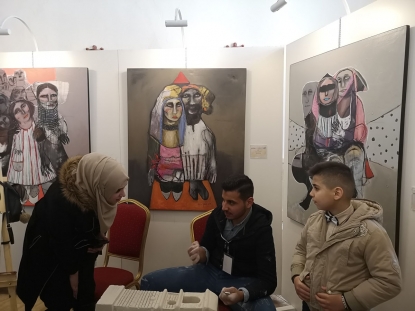 Artists in Mosul, February, 2019. (Photo courtesy of Maya Gebeily)
Artists in Mosul, February, 2019. (Photo courtesy of Maya Gebeily)Days after my trip to Mosul, AFP sent me on assignment to eastern Syria, where the US-backed Syrian Democratic Forces were bearing down on IS's last pocket of territory, a tiny town called Baghouz. We covered the civilian exodus, foreign fighters in detention, and humanitarian concerns in displacement camps for two weeks and were set to return home -- but we wanted a glimpse of Raqa first.
IS had claimed Raqa as its de facto Syrian capital for several years, flaunting its implementation of sharia law there and carrying out mass executions in Al-Naim Square. My colleagues and I spent a month in 2017 covering the SDF's battle to capture the city -- an offensive backed by ferocious US-led coalition air strikes that had smashed Raqa into a monochromatic wasteland, emptied of its residents. That entire month of reporting was building up to a single moment, the end of IS rule in its Syrian capital. It was, as far as the world was concerned, a one-story city.
Returning in February, I found a one-storey city. Only the ground floor of most buildings were functional homes or shops, as residents had the means to clear just a single floor of the mines IS had left behind. There, they had reopened storefronts selling clothes and construction materials, restaurants serving up sloppy fatteh and crunchy rings of falafel. But everything above had remained a tangled grey mess of precarious slabs of concrete and rebar that threatened to collapse at any moment. Here, as in Mosul, bulldozers were mostly still being used to tear buildings down and pull out rotting corpses. And like Mosul's divide between east and west, old and new, Raqa was schizophrenically split between its ground and upper floors.
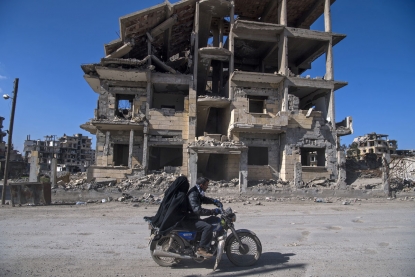 A Syrian couple rides a motorcycle past a destroyed building in the Islamic State (IS) group's former Syrian capital of Raqa in northern Syria, on February 19, 2019. (AFP / Fadel Senna)
A Syrian couple rides a motorcycle past a destroyed building in the Islamic State (IS) group's former Syrian capital of Raqa in northern Syria, on February 19, 2019. (AFP / Fadel Senna)Being back brought some surreal reunions. In 2017, my colleagues and I had interviewed members of the Raqa Civil Council, a sort of municipality-in-exile that was based further north as the battle over their hometown was still raging. From there, they prepared to govern the city as soon as it was recaptured from IS. Now, they were based inside a massive concrete complex inside Raqa itself, and I ran into one of the council's media officials, Mohammad. He had been a little standoffish in 2017, and that -- along with his impossibly blue eyes -- hadn't changed. But everything around them seemed to have hardened into clay. The wrinkles in his forehead, the folds around his mouth. The breathless optimism with which he had discussed rebuilding his native Raqa was gone, replaced by a realistic, bureaucratic coldness.
"Congratulations. it's great to see you in the city now instead of in Ain Issa. How are things?" I said with a grin as I approached his massive desk to shake his hand.
"Plenty of work. Welcome back," he said dryly, gesturing to a stack of papers.
There was also Ahmad, a lanky SDF press officer who had regularly accompanied us for embeds into his native Raqa. He had since moved back into the city with his wife and was now working as a civilian fixer for foreign journalists covering Baghouz. His braces were gone. He had swapped military fatigues for a fleece and jeans.
"Are you looking forward to the end of the battle? You've been working in Daesh-related things for so long," I asked after a hug.
"We're tired of war. But it was our livelihood either way," he shrugged. "When the battles end, when the journalists leave, I don't know what I'll do for work anymore."
 A close up shot shows the legs of Iraqis who lost their limbs in the offensive to retake the city of Mosul from Islamic State (IS) fighters, as they gather to try prosthetic limbs provided by the Kuwaiti government on January 16, 2018, in Arbil, the capital of the Kurdish autonomous region in northern Iraq. (AFP / Safin Hamed)
A close up shot shows the legs of Iraqis who lost their limbs in the offensive to retake the city of Mosul from Islamic State (IS) fighters, as they gather to try prosthetic limbs provided by the Kuwaiti government on January 16, 2018, in Arbil, the capital of the Kurdish autonomous region in northern Iraq. (AFP / Safin Hamed)Raqa and Mosul are old, unfathomably rich cities. In their storied pasts, they have changed hands perhaps dozens of times, with IS's rule only the most recent episode. But it destroyed and ultimately defined them, thanks to the sheer might of modern militaries and the 24-hour news cycle. As correspondents in war-time, we counted the number of air strikes and car bombs in a given morning, the neighbourhoods retaken and the mounting death tolls. We watched one flag torn down and replaced by another. We told the stories of fleeing families, and collapsing infrastructure.
But how can we faithfully cover a city's attempted resurrection? How do we measure whether Mosul's families trust each other again? Are a few hours in Raqa enough to suss out whether Syrians in the onetime jihadist bastion feel safe? If we truly care about getting the story right, we should dive in to the ambiguity and directionless of its aftermath. We must cover the messy affair of civil revival with as much dedication as we followed military takeover -- because, as far as the residents of Mosul and Raqa are concerned, the battle isn't over.
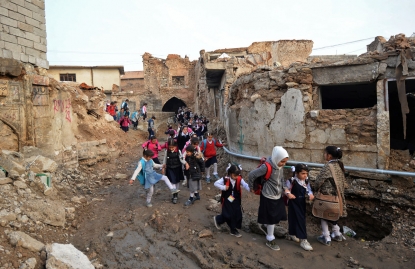 Iraqi students walk through a damaged road on their way back from school in the northern city of Mosul on November 28, 2018. (AFP / Zaid Al-obeidi)
Iraqi students walk through a damaged road on their way back from school in the northern city of Mosul on November 28, 2018. (AFP / Zaid Al-obeidi)


